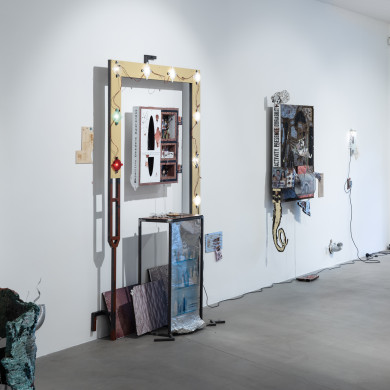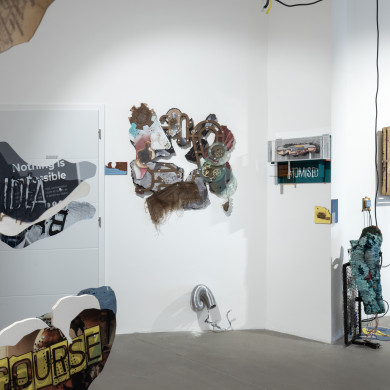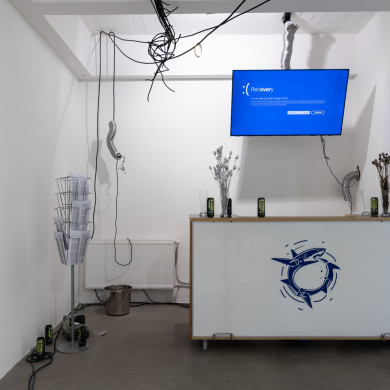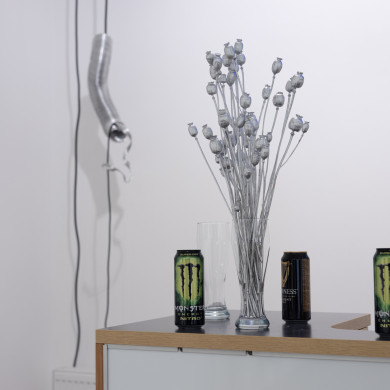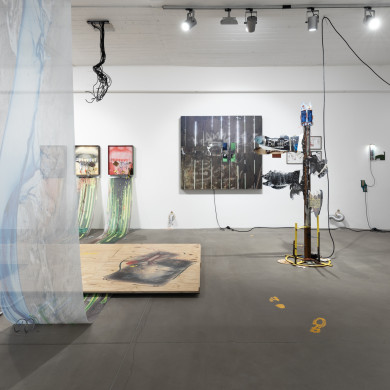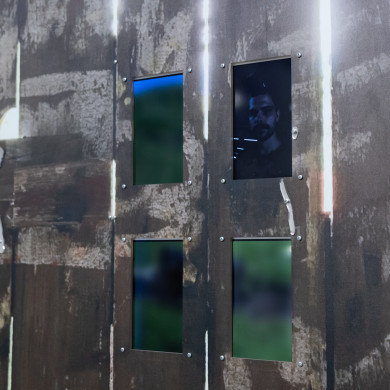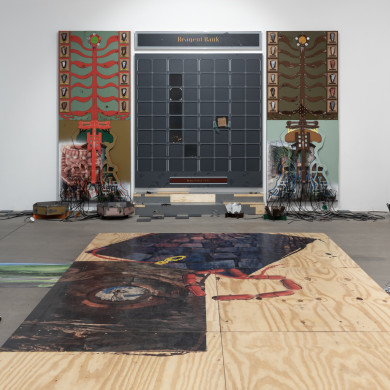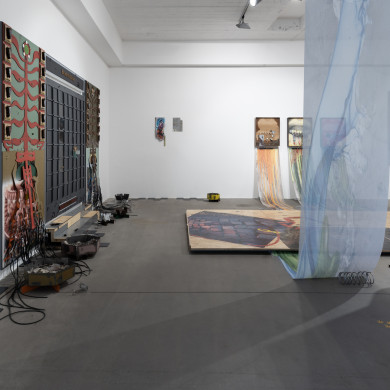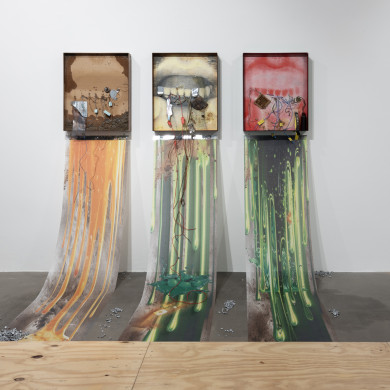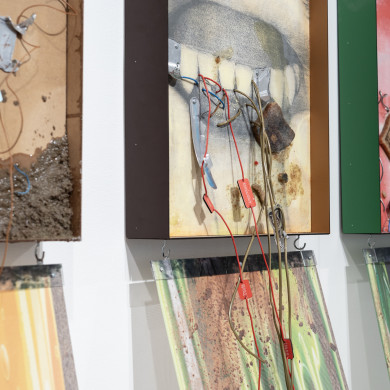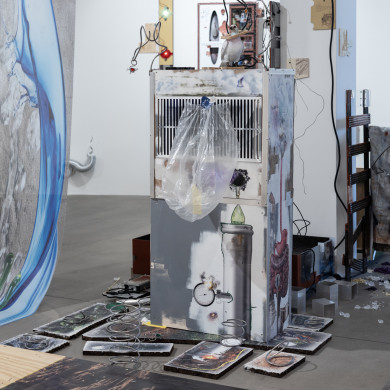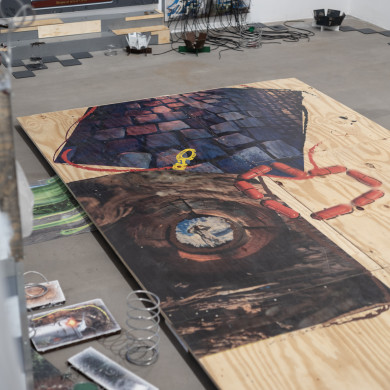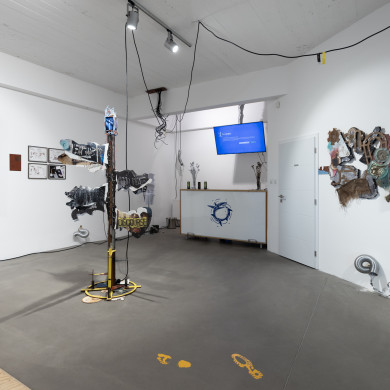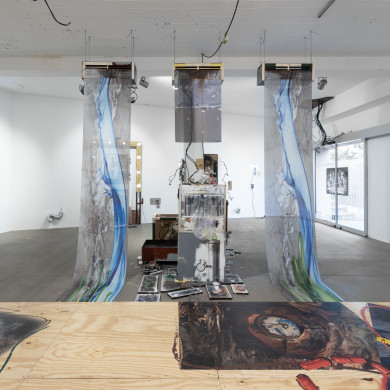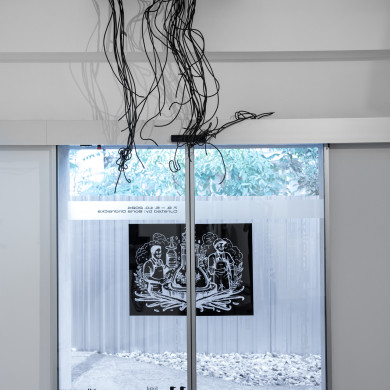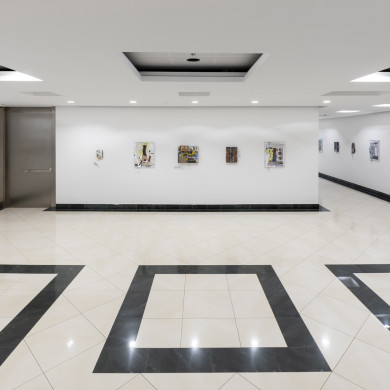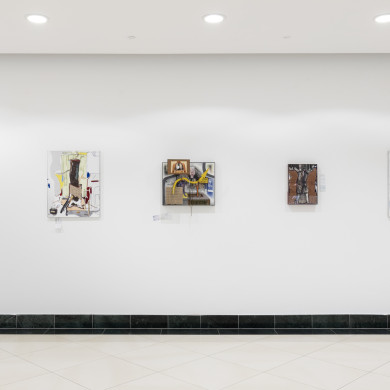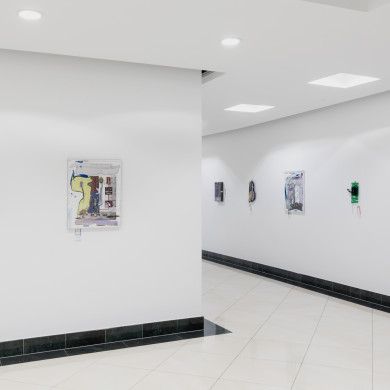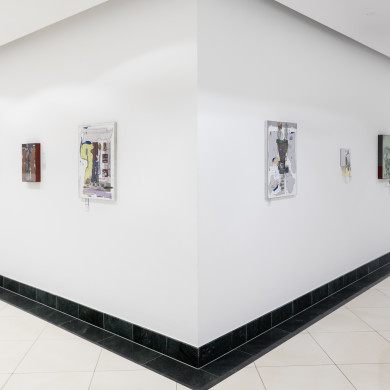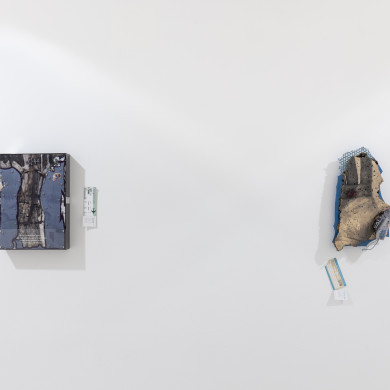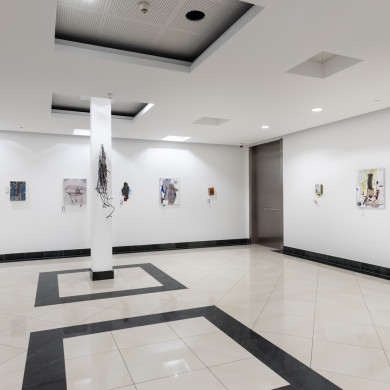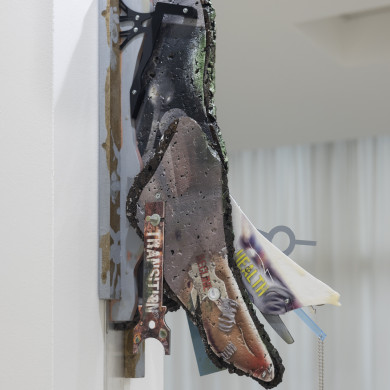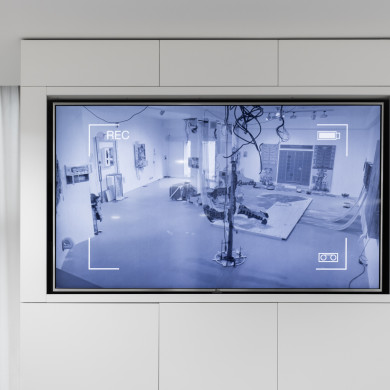JAKUB CHOMA
We Are Smelly, Atomised, Chemical, Vanilla, Succumb, Exhausted, Delirious, Digestive, Spiritual, Laborers
6.9. – 5.10.2024
ZAHORIAN & VAN ESPEN, Mierová 7, Bratislava
We Are Smelly, Atomised, Chemical, Vanilla, Succumb, Exhausted, Delirious
6.9.2024 – 10.1.2025
ZAHORIAN & VAN ESPEN, Carlton Savoy, Bratislava
v kurátorskej koncepcii Borisa Ondreičku
Ak niekto niečo niekedy vyhlási za umelecké dielo, už niet argumentov to spochybniť. Umelecké dielo je obojstranná priepustná membrána (alebo tablet) medzi vonkajšou realitou všetkých (my) a vnútornou realitou autora (ja). Tento, dá sa povedať, transparentný medzi-priestor (lebo ani hárok papiera nie je 2d) vyzýva na stretnutie následných hráčov. Je to hra bez pravidiel. Hra sa skloňuje ako v športe, tak aj v umeniach či najobyčajnejšej zábave. Termín 3d sa tiež používa v široko polemických rozprestierateľnostiach možných významov.
Ako to definovala Marisa Olsonová (1), „post-internet“ neoznačuje predstavy po skončení internetu, ale myslenie, tvorbu, ktorej je internet integrálnou súčasťou, ale ona sama sa nemusí nevyhnutne ocitať (len) online. Internet („medzi-sieť“) je priestor. Je to stále mladá externá kultúrna, zmyslová a cerebrálna, metastatická a diasporická protéza. Je všadeprítomne nedeliteľná od interného starého prírodného tela a zvyšku univerza (IoE2). Internet je techlepatický (3). Podstatné porcie skutočnosti halucinujeme cezeň. Jeho línie, drôty, synapsie sú energetické. Ich zdroje sú metalické. Internet je „my“ 21. storočia. Post-internet je súčasťou nového normálu. Olsonová ho charakterizuje ako „presieťovanú prírodu“ (4). Protetické dominuje originálnemu, tak ako aj asociované významy vládnu pôvodným obsahom slov (5). V predĺžení internet nadväzuje na antický mýtus farmakonu – daru písania od boha Thotha. Písanie externalizuje pamäť a tak prispieva k neuroplasticite následných mozgov. Písanie mení pamäť na pripomínanie. Písanie samo je kresbou. Môže byť liekom, drogou či jedom. Slovo je ako subjekt, tak objekt. Fygitálna (6) presieťovaná príroda vytvára extrémne množstvo stimulov. Ľudstvo tak zmenila na hyper-reaktívne informačné spoločnosti (7). Naše nedeliteľné konverzácie (smerom k všestranným konverziám) spochybňujú právoplatnosť ako vonkajšieho a vnútorného, tak ja a my, soft i hard, vysokého/nízkeho, živého/neživého, prírodného/kultúrneho, ľudského/strojového, fiktívneho (metaforického, mystického…) či faktického, reálneho či virtuálneho, pravdu, zdanie a lož. Takéto normatívne koordináty nikdy neboli úplne spoľahlivé, až sú dnes totálne banálnymi. A ak by niekto chcel odvíjať spoznávanie sveta od ich striktného odlišovania, tak sa ľahko ocitne v slepej jednosmerke.
Toto všetko (hypridné8) Jakub Choma chronicky ovláda a my to máme šancu spoznávať v jeho dielach. V jeho tvorbe si vnútorné a vonkajšie často menia pozície. Vnútorné, konkávne sa vyvracia na vonkajšie, konvexné (a vice versa). Sú to dve strany jednej membrány. Jeho variabilné objekty (alebo komponenty) sú ako produktmi vedomej snahy, tak sprievodným javom automatického vstrebávania fygitálnych súcien. Tu môžeme špekulovať, či médiom je to, čo tvoríme, alebo či my sami nie sme médiami „an sich selbst“. Hej, (už) nie je fixným, čo je podmienené čím. Veci medzi sebou nepretržite korelujú bilaterálne. Choma si plne uvedomuje a vyjadruje, že aj laptop má svoj pach, že (post-)internet je ako slasti plný vanilkový cukor, ktorý sa mení na psychedelický alkohol. Od toho „špiritusu“ sme závislí. Systematický priestor medzi objektmi (inter, meta a dia, miesto prieskumu, stavby, uskladnenia, re/-prezentácie či iba „nemiesto“ prechodu…) je preňho rovnako dôležitý ako objekty samy. A tak sa pohráva s otázkami mennej pozície, štafiet dočasných autonómií, kombinatoriky, post/-produkcie a re/-distribúcie, interakcie a participácie, znaku, ikony, symbolu, obrazu. Obraz – „image“ v jeho práci zostáva larvou imága. Obraz je uňho do strán otvoreným objektom a tá otvorenosť si privlastňuje priestor okolo a tak sa stáva priestorom sám (bývalý) objekt. Kompatibilita a konektivita sú tu výraznými témami. Jeho multimediálna tvorba je prebiehajúca metamorfóza ešte levitujúceho stávania sa a nie nevyhnutne už uzemneného bytia. Teda k spomínanému „post-“ vždy musíme pridať aj dynamické (experimentálne, imaginatívne) „proto-“. Áno, jeho procesuálne a samo-performatívne, animačné práce sú synkretickými prototypmi často spontánne vychádzajúcimi z neuroestetických bádaní (9). Animácia (z latinského anima = duša a duša je energiou nabitý plyn, čo smrdí) znamená oživovanie. Ovzdušie je preplnené psychotickými kmitočtami komunikácie. Supermodernita už dávno nie je tekutá, ale prchavo plynná. Všetko visí vo vzduchu (10). Prúd a prúd. Choma skoro vždy pridáva vrstvy efemérnych ingrediencií do svojich (ako keby molekulárnych) konštelácií, s vedomím, že aj odpad sa stal ďalšou valutou. Voľakedy nové médiá už majú svoju archeológiu (11) i reštaurátorstvo. Nové zmizlo, ale ostalo diverzné súčasné. Už nám nič nestojí v ceste. A to, čo nás lokálne ochladzuje, zároveň masívne prispieva ku globálnemu otepľovaniu. Mokrý sen nemateriálneho vytvára suchú materiálnu nočnú moru. Všetko sa každú sekundu stáva niečím iným. A „ak je príroda nespravodlivá, zmeňme prírodu!“ (12)
Výstava Jakuba Chomu v ZAHORIAN & VAN ESPEN v Bratislave sa skladá z dvoch navzájom sa doplňujúcich, avšak aj samostatne svojbytných častí. Priestor na Mierovej je miestom, kam návštevníci prichádzajú po vedomom rozhodnutí a zoskupujú sa centrálne. Priestor na Mostovej je lineárnym „nemiestom“ (13), žilou v rozmernejšom sociálne-architektonickom korpuse, ktorá víta predovšetkým návštevníkov iných orgánov celého tela domu ním prechádzajúcich. Chomov part na Mierovej ulici (We Are Smelly, Atomised, Chemical, Vanilla, Succumb, Exhausted, Delirious, Exhausted, Digestive, Spiritual, Laborers) je tak vybudovaný ako komplexná reorganizácia (ekosystém, metabolizmus…) postprodukujúca projekty posledných ôsmich rokov. Part na Mostovej (We Are Smelly, Atomised, Chemical, Vanilla, Succumb, Exhausted, Delirious14) je súvislý prúd (akýsi tranzit) samostatných objektov, ktorý môže evokovať slučku filmovej montáže – montáže brikoláží. Obe výstavy prepája kvázi-CCTV telemost. Tento vzťahový diptych chce vyzdvihnúť kvality variability a adaptability v Chomovom diele a predstavovať rôzne formy vnímania, resp. chápania jeho vecí. Choma pracuje s časom prirodzene v zmysle najsúčasnejšieho umenia. Ide zároveň s časom, ako aj proti nemu. Tak aj čítanie jeho prác je obojsmerné.
Jakub Choma (*1995, Košice) absolvoval štúdium v roku 2023 v ateliéri maľby Jiřího Černického a Michala Novotného na Vysokej škole umelecko-priemyslovej v Prahe. Už počas štúdia získal Cenu Jindřicha Chalupeckého za rok 2020, čo je najprestížnejšia česká umelecká cena pre začínajúcich umelcov. Miešaním rôznych médií, ako je maľba, asambláž, socha, zvuk a video, vytvára komplexné inštalácie oslovujúce našu telesnú existenciu v rámci súčasnej digitálnej infraštruktúry.
Choma hojne vystavuje doma aj v zahraničí. Medzi jeho sólové projekty patria Life for Dummies (2017) a Stepping on a Lego (2018) v galérii Polansky Gallery v Prahe, Living the Gimmick (2018) v galérii VUNU Košice, Resilience (2019) v galérii Editorial vo Vilniuse, Distant Hum (2021) v experimentálnom priestore NoD v Prahe, Childishly Fresh Eyes (2022) v galérii Zaazrak Dornych v Brne, Metallic Aftertaste (2023) predstavený na veľtrhu Vienna Contemporary, Cold Cord (2024) v olomouckom Basement Project a najnovšie We Are Smelly, Atomised, Chemical, Vanilla (2024) v Galerii Smečky v Prahe. Jeho práce sú súčasťou mnohých skupinových výstav vo viacerých krajinách, vrátane výstav v galériách Basis vo Frankfurte, Galeria Municipal v Porte a Cuchifritos Gallery v New Yorku, ako aj niekoľkých ďalších v Štokholme, Viedni, Budapešti, Walese, Rige a inde. Chomove diela boli tiež prezentované na niekoľkých off-site výstavách a sú často prítomné na online kurátorských umeleckých platformách, ako napr. O Fluxo, pre ktorú vytvoril online projekty Wounds Heal Faster in a Metallic Mouth (2020) a Beta Ground (Delirium Obstacle) (2019). Napriek svojmu mladému veku sa Choma už dvakrát zúčastnil na veľtrhu Liste Art Fair Basel, a to jednak samostatne (2021), ale aj v spolupráci s Pakui Hardware (2019). V roku 2022 mu bol udelený pobyt v New Yorku v rámci programu Residency Unlimited. Chomu zastupuje bratislavská galéria ZAHORIAN & VAN ESPEN. Autor žije a tvorí v Prahe.
1 Interview vo We Make Money Not Art (28. marca 2008, online)
2 Internet of Everything = zosieťované spojenia ľudí, procesov, dát a vecí (Cisco, 2013)
3 spojenie technológie + telepatie, George Dvorsky v jeho Evolving Towards Telepathy (Betterhumans, 26. apríla 2004, online)
4 v jej Networked Nature (Foxy Production / Rhizome, 2007)
5 čítaj aj elementárne The Measurement of Meaning od Charlesa E. Osgooda (a kolektív, University of Illinois Press, 1967),)
6 holistické spojenie fyzického + digitálneho, Chris Weil (Momentum Worldwide, 2007), ktoré pripomína, že za čímkoľvek „nemateriálnym“ (soft) sa vždy nachádza materiálny substrát (hard)
7 čítaj aj elementárne The Production and Distribution of Knowledge in the United States od Fritza Machlupa (Princeton University Press, 1962)
8 spájam hybrid + hyper
9 tak ako to definoval Semir Zeki vo svojej Inner Vision: an exploration of art and the brain (1999, Oxford University Press), kde spája estetické, emočné… s neurobiologickým, ale aj Eric Kandel v jeho The Age of Insight: The Quest to Understand the Unconscious in Art, Mind, and Brain, from Vienna 1900 to the Present (2012, Random House), kde sa díva na umenie od viedenského Jugendstilu z pozície neuro-psychiatrie
10 Najvýznamnejší popularizátor termínu antropocén, meteorológ a atmosférický chemik Paul Jozef Crutzen, odvíjal svoje sledovania drastického vplyvu človeka na prírodu práve štúdiom vzduchu.
11 ako to definoval Jussi Parikka vo svojej What is Media Archaeology? (Politi, 2012)
12 v manifeste techno-feministického kolektívu Laboria Cuboniks Xenofeminism: A Politics for Alienation (jún, 2015)
13 tak ako to definoval Marc Auge vo svojej ikonickej Non-Places: Introduction to an Anthropology of Supermodernity (Verso, 1995), kde vyzdvihuje význam časo-priestorovo limitovaných intervalov ako chodba, eskalátor, supermarket, diaľnica, hotel, letisko, bankomat, počítač… v sociálnej interaktivite infraštruktúr
14 We Are Smelly, Atomised, Chemical, Vanilla pre svoju tesne predošlú výstavu (Galerie Smečky, Praha, 2024) Choma nadväzuje na jeho čítanie novely The Boiled in Between od Helen Marten (Prototype, 2020)
Projekt podporil z verejných zdrojov Fond na podporu umenia ![]()
JAKUB CHOMA
We Are Smelly, Atomised, Chemical, Vanilla, Succumb, Exhausted, Delirious, Digestive, Spiritual, Laborers
6 Sep – 5 Oct 2024
ZAHORIAN & VAN ESPEN, Mierová 7, Bratislava
We Are Smelly, Atomised, Chemical, Vanilla, Succumb, Exhausted, Delirious
6 Sep 2024 – 10 Jan 2025,
ZAHORIAN & VAN ESPEN, Carlton Savoy, Bratislava
in a curatorial concept by Boris Ondreička
If someone at some time declares that something is a work of art, there are no longer any arguments to contest that. An art work is a two-sided porous membrane (or tablet) between the outer reality of everybody (we) and the inner reality of the artist (I). This transparent inter-space, as one may call it (because even a sheet of paper is not 2d), summons the subsequent players to an encounter. Their game has no rules. “Game” is declined as in sport, so likewise in the arts and in common entertainment. The term 3d is also widely employed in polemical fashion, to enhance the dissemination of possible meanings.
As defined by Marisa Olson (1), “post-internet” does not designate ideas of things after the ending of the internet; rather, it means thinking and art in which the internet is integrally part, though the work need not itself appear (only) online. The internet is a space. It is a still young external cultural, sensual and cerebral, metastatic and diasporic prosthesis. It is ubiquitously inseparable from the old natural body and remnant of the universe (IoE2). The internet is techlepathic (3). Through it we hallucinate essential portions of reality. Its lines, wires and synapses are energetic. Its sources are metallic. The internet is 21st century “us”. Post-internet is part of the new normal. Olson characterises it as “networked Nature” (4). The prosthetic dominates the original, and also the connotative significances prevail over the original contents of words (5). In extension, the internet follows on from the ancient myth of the pharmakon: the gift of writing from the god Thoth. Writing externalises memory, thus contributing to the neuroplasticity of subsequent brains. Writing changes memory to recollection. Writing is itself a sketch. It may be a medicine, drug or poison. The word as subject is an object. Phygital (6) networked Nature creates an extreme multitude of stimuli. It has thereby changed humanity to a hyper-reactive information society (7). Our indivisible conversations (going in the direction of all-sided conversions) put in question the validity of the distinction of outer and inner, and equally that of I and we, soft and hard, high / low, animate / inanimate, natural / cultural, human / mechanical, fictive (metaphoric, mystic…) or factual, real or virtual, truth, appearance and lie. Such normative coordinates were never entirely reliable and by now are totally banal. And anyone who wants to unfold knowledge of the world from their strict distinction can easily end up in a blind unidirectionality.
Jakub Choma chronically commands all of this (hypridity8), and his works offer us a chance to make its acquaintance. Inner and outer frequently change position in his art. The inner, concave is transposed to the outer, convex (and vice-versa). Those are two sides of the one membrane. His variable objects (or components) are, as products of conscious effort, thereby an accompanying phenomenon of the automatic absorption of phygital realities. Here we may speculate whether the medium is what we create, or whether we are media “an sich selbst”. Yes, what conditions what is no longer fixed! Things incessantly correlate bilaterally with one another. Choma fully understands this, and he declares that even a laptop has its odour and the (post-)internet is like a delicious vanilla sugar that changes to psychedelic alcohol. We are addicted to the “spirits” in question. The systemic space between objects (inter, meta and dia, place of research, construction, storage, re/presentation, and even the “non-place” of transition…) is quite as important to him as the objects themselves. And thus he plays with issues of mutable position, relays of temporary autonomy, combinatorics, post/ production and re/distribution, interaction and participation, sign, icon, symbol, image. The “image” in his work remains the larva of an imago. With him the image is an object open at the sides, and this openness appropriates the space around, and thus the (former) object itself becomes space. Compatibility and connectivity are important themes here. His multimedia work is the ongoing metamorphosis of a still levitating becoming, and not inevitably of an already grounded being. Hence to the aforementioned “post” we must always add a dynamic (experimental, imaginative) “proto-“. Yes, his processual and auto-performative, animating works are syncretic prototypes that often spontaneously emerge from neuroaesthetic explorations (9). Animation (from the Latin anima, “soul” – and the soul is an energy-charged gas that stinks) means revival. The atmosphere is saturated with psychotic frequencies of communication. Supermodernity has long since not been liquid, but rather, vanishingly gaseous. Everything hangs in the air.(10). Stream and stream. Choma almost always adds layers of ephemeral ingredients to his (quasi-molecular) constellations, aware that even garbage has become another currency. What were once new media already have their archaeology (11) and their science of restoration. The new has vanished, but it has remained diversely contemporary. Nothing stands in our way any longer. And the very thing that cools us locally is at the same time contributing massively to global warming. A wet dream of the immaterial is creating a dry material nightmare. Every second, everything is becoming something else. And “if Nature is unjust, let us change Nature!” (12)
Jakuba Choma’s exhibition in ZAHORIAN & VAN ESPEN in Bratislava is composed of two mutually complementing but independent parts. The space at Mierová is a place where visitors arrive after conscious decision and gather centrally. The space at Mostová is a linear “non-place” (13), a vein in a more capacious social-architectural corpus, which above all welcomes visitors to other organs throughout the body of the house, who are passing through this one. Choma’s part on Mierová Street (We Are Smelly, Atomised, Chemical, Vanilla, Succumb, Exhausted, Delirious, Exhausted, Digestive, Spiritual, Laborers) is therefore constructed as a complex reorganisation (ecosystem, metabolism…) postproducing projects of the last eight years. The part at Mostová (We Are Smelly, Atomised, Chemical, Vanilla, Succumb, Exhausted, Delirious (14) is a continuous stream (a kind of transit) of independent objects, which may evoke a film montage loop – a montage of bricolages. The two exhibitions are linked by a quasi-CCTV telemost. This relational diptych aims to exalt the qualities of variability and adaptability in Choma’s work and introduce a variety of forms of perceiving/comprehending his things/his thing. Choma works with time, naturally on the lines of the most up-to-date art. Simultaneously, he goes with time and against time. Hence the reading of his work(s) also is two-way.
Jakub Choma (*1995, Košice) graduated in 2023 from the painting studio of Jiří Černický and Michal Novotný at the Academy of Arts, Architecture and Design in Prague. Already during his studies, he was awarded the Jindřich Chalupecký Award for 2020, the most prestigious Czech art prize for emerging artists. Mixing diverse media such as painting, assemblage, sculpture, sound, and video, he creates complex installations addressing our bodily existence within the present digital infrastructure. Choma exhibits prolifically both at home and abroad. His solo projects include Life for Dummies (2017) and Stepping on a Lego (2018) at Polansky Gallery in Prague, Living the Gimmick (2018) in VUNU Gallery Košice, Resilience (2019) in Vilnius’ Editorial, Distant Hum (2021) in Prague’s NoD space, Childishly Fresh Eyes (2022) at Zaazrak Dornych in Brno, Metallic Aftertaste (2023) presented at Vienna Contemporary, Cold Cord (2024) in Olomouc’s Basement Project, and most recently, We Are Smelly, Atomised, Chemical, Vanilla (2024) at Galerie Smečky in Prague. His work has been part of many group exhibitions across numerous countries, including shows at Basis in Frankfurt, Galeria Municipal in Porto, and Cuchifritos Gallery in New York, as well as several others in Stockholm, Vienna, Budapest, Wales, Riga, and others. Choma’s pieces were also featured in several off-site shows and are often present on online curatorial art platforms such as O Fluxo, for which he created the online projects Wounds Heal Faster in a Metallic Mouth (2020) and Beta Ground (Delirium Obstacle) (2019). Despite his young age, Choma has already twice participated in Liste Art Fair Basel, both alone (2021) and in collaboration with Pakui Hardware (2019). In 2022 he was awarded a residency in New York City with Residency Unlimited. Choma is represented by the Bratislava-based ZAHORIAN & VAN ESPEN gallery. He lives and works in Prague.
1 Interview in We Make Money Not Art (March 28, 2008, online)
2 Internet of Everything = zosieťované spojenia ľudí, procesov, dát a vecí (networked connection of people, processes, data
and things. — Cisco, 2013)
3 Linking of technology + telepathy: George Dvorsky) in his: Evolving Towards Telepathy (Betterhumans, April 26, 2004, online
4 In her Networked Nature (Foxy Production / Rhizome, 2007)
5 Cf. also the elementary study The Measurement of Meaning by Charles E. Osgood (and collective, University of Illinois Press, 1967).
6 Holistic linking of physical and digital: Chris Weil (Momentum Worldwide, 2007), who points out that behind anything “non- material” (soft) one will always find a material substrate (hard).
7 Cf. also the elementary study The Production and Distribution of Knowledge in the United States by Fritz Machlup (Princeton University Press, 1962).
8 Linking hybrid + hyper.
9 As defined by Semir Zeki in Inner Vision: an exploration of art and the brain (1999, Oxford University Press), where he links the aesthetic, emotional… with the neurobiological; and also Eric Kandel in The Age of Insight: The Quest to Understand the Unconscious in Art, Mind, and Brain, from Vienna 1900 to the Present (2012, Random House), where he looks at the art of the Vienna Jugendstil from the position of neuropsychiatry.
10 The most important populariser of the term anthropocene, the meteorologist and atmospherical chemist Paul Jozef Crutzen, unfolded his tracking of the drastic influence of man on Nature precisely from a study of air.
11 As defined by Jussi Parikka in What is Media Archaeology? (Politi, 2012).
12 In the manifesto of the techno-feminist collective Laboria Cuboniks Xenofeminism: A Politics for Alienation (June 2015).
13 As defined by Marc Auge in his iconic Non-Places: Introduction to an Anthropology of Supermodernity (Verso, 1995), where he exalts the significance of time-space limited intervals such as corridor, escalator, supermarket, highway, hotel, airport, ATM, computer… in the social interactivity of infrastructures.
14 We Are Smelly, Atomised, Chemical, Vanilla, as exhibited a short time previously (Galerie Smečky, Praha, 2024), was linked by Choma with his reading of Helen Marten’s story The Boiled in Between (Prototype, 2020)

